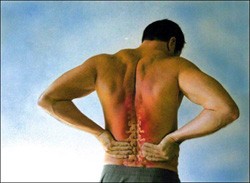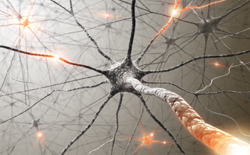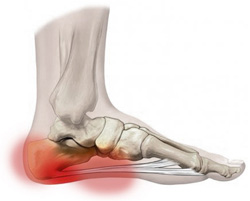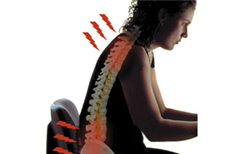
Treatable Conditions With Chiropractic Care
A few of these conditions are explained below to help you understand how the body is affected during times of pain. If you have questions about whether or not we can treat a condition, please give us a call at 314-896-3550.
Bulging Disc & Back Pain
 One of the most common causes of back pain is a bulging or herniated disc. These conditions can occur at a moment’s notice or gradually develop over time due to muscular imbalances and improper posture.
One of the most common causes of back pain is a bulging or herniated disc. These conditions can occur at a moment’s notice or gradually develop over time due to muscular imbalances and improper posture.
When a disc is compromised or stressed, the nerve fibers which sense pain in the disc become extremely aggravated causing a mess of painful reactions and inflammation. When this occurs, a person suffers tremendously. Even simple tasks such as sitting, rolling over in bed and bending over are nearly impossible.
The discs of the spine receive nourishment through blood vessels into a person’s early twenties. Over the years the normal aging processes dehydrates the discs making them thinner. This process is called degeneration and is synonymous with arthritis. People with a history of trauma such as whiplash and sports injuries will degenerate more rapidly than others.
Bulging Discs – At the core of each disc is a jelly-like substance, called the nucleus. Excessive stress and degeneration causes the jelly-like material inside the disc to “bulge” or “slip” out of place. As this occurs, the bulge itself puts pressure on other structures near the disc, such as nerves causing intense pain. A person suffering from this condition may feel pain down their leg and experience tingling in their foot.
Fibromyalgia
Fibromyalgia is a debilitating syndrome impacting 3-6 million people in the United States. Affecting mostly women, fibromyalgia is a collection of symptoms that often incapacitate its victims. Medication dependence, loss of work and nominal quality of life all reinforce a person’s symptoms as they bounce from doctor to doctor in search of relief.
Often a collection of treatments, lifestyle changes and counseling is needed to reduce symptoms and restore some semblance of a normal life.
Some of the common signs and symptoms associated with fibromyalgia are:
- Wide Spread Pain
- Tender Joints
- Trouble Sleeping
- Drowsiness
- Mood Changes
- Headaches
- Diarrhea
- Numbness and Tingles
- Abdominal Pain
- Constipation
- Difficulty Concentrating
Headaches
 According to the latest research, 9% of men and 12% of women in the U.S. experience at least 1-2 headache episodes per month. And, more than 4% of the U.S. population suffers from frequent headaches, defined as headaches that occur at least 180 days a year. Needless to say, headaches have become a social and economic burden in the United States, as well as other parts of the world.
According to the latest research, 9% of men and 12% of women in the U.S. experience at least 1-2 headache episodes per month. And, more than 4% of the U.S. population suffers from frequent headaches, defined as headaches that occur at least 180 days a year. Needless to say, headaches have become a social and economic burden in the United States, as well as other parts of the world.
Scientists have identified over 300 causes for headaches. Various pain-sensitive structures and tissues including the skin, subcutaneous tissue, muscles, arteries, periosteal bone covering, and the upper cervical and facial nerves produce headaches when irritated or injured. Fortunately, only a handful of causes are responsible for the majority of headaches.
The most common of these headaches include:
- Cervicogenic: problems within the neck
- Migraines
- Muscle-Tensions: neck and upper back muscular spasms
- Drug-Induced: from analgesic overuse
- Cluster
- Post-Traumatic: following head/neck trauma, i.e. whiplash
Chiropractors Doctors of chiropractic successfully help thousands of individuals everyday obtain safe, effective, long-term relief from their headaches. This is because most headaches have a spinal, muscular, or habitual component which the chiropractor has been trained to identify and treat. In fact, surveys show that 10-25% of patients initiate chiropractic care for the relief of headaches.
To learn more about specific headache types, headache treatments, or prevention tips please call the office and schedule an appointment at 314-628-9895.
Neck Pain
 Neck pain affects a significant number of individuals. Recent studies have found more than 10% of Americans suffer from neck pain at any given time.
Neck pain affects a significant number of individuals. Recent studies have found more than 10% of Americans suffer from neck pain at any given time.
The reason is that the neck region contains many delicate, pain sensitive structures commonly exposed to abuse and abnormal stresses. Incomplete rehabilitation of past injuries, poor posture, prolonged sitting, and lack of periodic spinal alignments are some of the more common factors in the development of neck problems.
Fortunately, most individuals suffering from neck problems will find chiropractic care extremely beneficial. Unlike prescription drugs, most chiropractic procedures address the cause of the majority of neck problems, not simply the symptoms. Best of all, chiropractic care is safe, natural, and noninvasive… no side effects allowed!
Nerve Pain
 If you have been suffering from sciatica or a related condition, you can ease nerve pain with chiropractic treatment. Most nerve pain is caused by a sudden traumatic event; such as, in a car accident or by a football injury. Cumulative stress and damage from poor posture or being significantly overweight may also lead to nerve pain over time. Chiropractic adjustments can correct many of the physical imbalances that cause this damage.
If you have been suffering from sciatica or a related condition, you can ease nerve pain with chiropractic treatment. Most nerve pain is caused by a sudden traumatic event; such as, in a car accident or by a football injury. Cumulative stress and damage from poor posture or being significantly overweight may also lead to nerve pain over time. Chiropractic adjustments can correct many of the physical imbalances that cause this damage.
When you see your chiropractor for treatment to ease nerve pain, he or she will first perform a full examination. This will help the chiropractor narrow down the exact source of the nerve pain. Sciatica is the most common cause, occurring when the vertebrae of the spine are out of alignment and pressing down on the sciatic nerve. Nerve pain can also occur in other areas of the body where ligaments and bones are not aligned correctly. It usually is felt as a mild burning or tingling sensation in the legs or back.
Because most of the discomfort is caused by pressure from the vertebrae or other bones, it is a natural fit to ease nerve pain with chiropractic treatment. Chiropractic adjustments can realign the vertebrae to relieve the pressure on the nerves and eliminate the pain. Often, this simple adjustment is all that is needed to relieve severe nerve pain. In addition to spinal adjustments, ice may be needed to reduce the swelling and inflammation in the area before the nerve pressure will be completely relieved.
Plantar Fasciitis
 Plantar fasciitis is an inflammation of the plantar fascia. This condition is typically characterized by a painful, inflammatory process of the foot area. Because of the pain and inflammation, most people find it difficult to walk, especially in the morning upon arising from bed. Longstanding cases of plantar fasciitis can demonstrate more degenerative changes than inflammatory changes, which would be termed plantar fasciosis.
Plantar fasciitis is an inflammation of the plantar fascia. This condition is typically characterized by a painful, inflammatory process of the foot area. Because of the pain and inflammation, most people find it difficult to walk, especially in the morning upon arising from bed. Longstanding cases of plantar fasciitis can demonstrate more degenerative changes than inflammatory changes, which would be termed plantar fasciosis.
How Can Chiropractic Care Help With Plantar Fasciitis?
Chiropractic physicians are trained to evaluate foot alignment and to adjust the bones of your ankle, foot and toes. Ask your chiropractor to look at your feet, your shoes, and how you stand, walk, and run. Even misalignment of the hips and knees can trigger or complicate the symptoms of plantar fasciitis. Your chiropractor can evaluate these areas of the bony structures and all adjunctive relieving approaches.
Repetitive Stress & Work Injuries
 Many chronic injuries and pains develop as a result of repetitive stresses occuring in the work place. Line workers who twist back and forth for eight hours a day, and warehouse employees who constantly bend over are just two examples of professions that require workers to repeatedly go through the same mechanical motions, over stressing the joints of their body.
Many chronic injuries and pains develop as a result of repetitive stresses occuring in the work place. Line workers who twist back and forth for eight hours a day, and warehouse employees who constantly bend over are just two examples of professions that require workers to repeatedly go through the same mechanical motions, over stressing the joints of their body.
If a person is constantly repeating the same movements, they are continuously over working the same muscular groups. While over working muscle groups during one particular motion, other muscles become neglected, creating an imbalance of the spine.
Sports Injuries
 Spinal injuries can restrict range of motion, reduce strength, slow reflexes, shorten endurance, and decrease performance. Chiropractic care for these types of injuries has become increasingly popular. Professional sports teams, Olympic trainers, and competitive athletes are employing chiropractic doctors – because the demand results.
Spinal injuries can restrict range of motion, reduce strength, slow reflexes, shorten endurance, and decrease performance. Chiropractic care for these types of injuries has become increasingly popular. Professional sports teams, Olympic trainers, and competitive athletes are employing chiropractic doctors – because the demand results.
Chiropractic care helps restore function to spinal joints that are “locked up”, fixated, and not moving properly. Besides helping to relieve pain, chiropractic care can also help reduce inflammation. Muscles, tendons, and ligaments depend upon proper joint movement for peak performance. Injuries to these tissues can reduce range of motion, affect delicate nerves, decrease blood supply and can take you out of the game. Normalizing spinal function helps speed the healing of these soft tissues and reduce the de-conditioning effect of being on the sidelines.
An aerobic exercise program or a plan of brisk walking can improve muscle tone and help you avoid strains, sprains, and other activity-restricting health problems. Whether you golf, play tennis, bicycle, or bowl, the best treatment for sports injuries is prevention!
Contact Phillips Chiropractic for a care plan based on your age, condition, and health objectives. Chiropractic care can restore your health, improve your performance, and increase your competitive edge.
TMJ, Jaw Pain, & Headaches
 The temporomandibular joint (TMJ) is a hinge joint that connects the mandible (jaw) to the skull and is surround by numerous pairs of muscles immediately in front of the ear on each side of the head. They allow you to chew, yawn, speak, and swallow and are in constant use. This is one of the most frequently used joints in the body. There is also an articular disk that separates the condyle head of the mandible and the skull. When this disk is misplaced it can cause dysfunction.
The temporomandibular joint (TMJ) is a hinge joint that connects the mandible (jaw) to the skull and is surround by numerous pairs of muscles immediately in front of the ear on each side of the head. They allow you to chew, yawn, speak, and swallow and are in constant use. This is one of the most frequently used joints in the body. There is also an articular disk that separates the condyle head of the mandible and the skull. When this disk is misplaced it can cause dysfunction.
Crowded teeth, grinding, stress, whiplash or excessively tight muscles that are causing a strain on the jaw can cause temporomandibular joint dysfunction.
A common symptom of this is decreased range of motion, popping, clicking, and pain. Each time that you open your mouth the dysfunction creates wear on the tissues of the joint. This can cause severe problems if not treated properly. The excess strain on the muscles and joint can also lead to headaches.
Chiropractic treatment of the TMJ focuses on relieving tension in these overactive muscles, checking the position of the articular disk, and correcting misalignments of the neck and upper back. Your chiropractor may even recommend a custom splint if necessary.
Whiplash
 Whiplash is a common occurrence in the United States. It is estimated that over six million auto accidents occur each year in the U.S. alone, many leaving the victims with painful neck and back injuries called whiplash.
Whiplash is a common occurrence in the United States. It is estimated that over six million auto accidents occur each year in the U.S. alone, many leaving the victims with painful neck and back injuries called whiplash.
When most people think of whiplash, they think of neck pain following a rear-end collision, but the truth is whiplash can occur anywhere in the spine and from almost any angle or impact. The traditional form of whiplash often occurs during a collision when a person’s spine is “jerked” too far backwards and too far forwards, putting excessive stress on the muscles, tendons, ligaments and joins which protect and hold a person’s spine together. Pain is often instantaneous but can also take several days to fully set in.
Common symptoms of whiplash included muscle and joint pain, muscle spasm, dizziness, headache and limited mobility. Sometimes the pain and symptoms retreat on their own, however often they do not, making normal day-to-day activities unbearable for people to live with. In either case, the underlying causes of the pain should be addressed by a qualified health care provider to reduce long-term damage and reoccurring pain.

